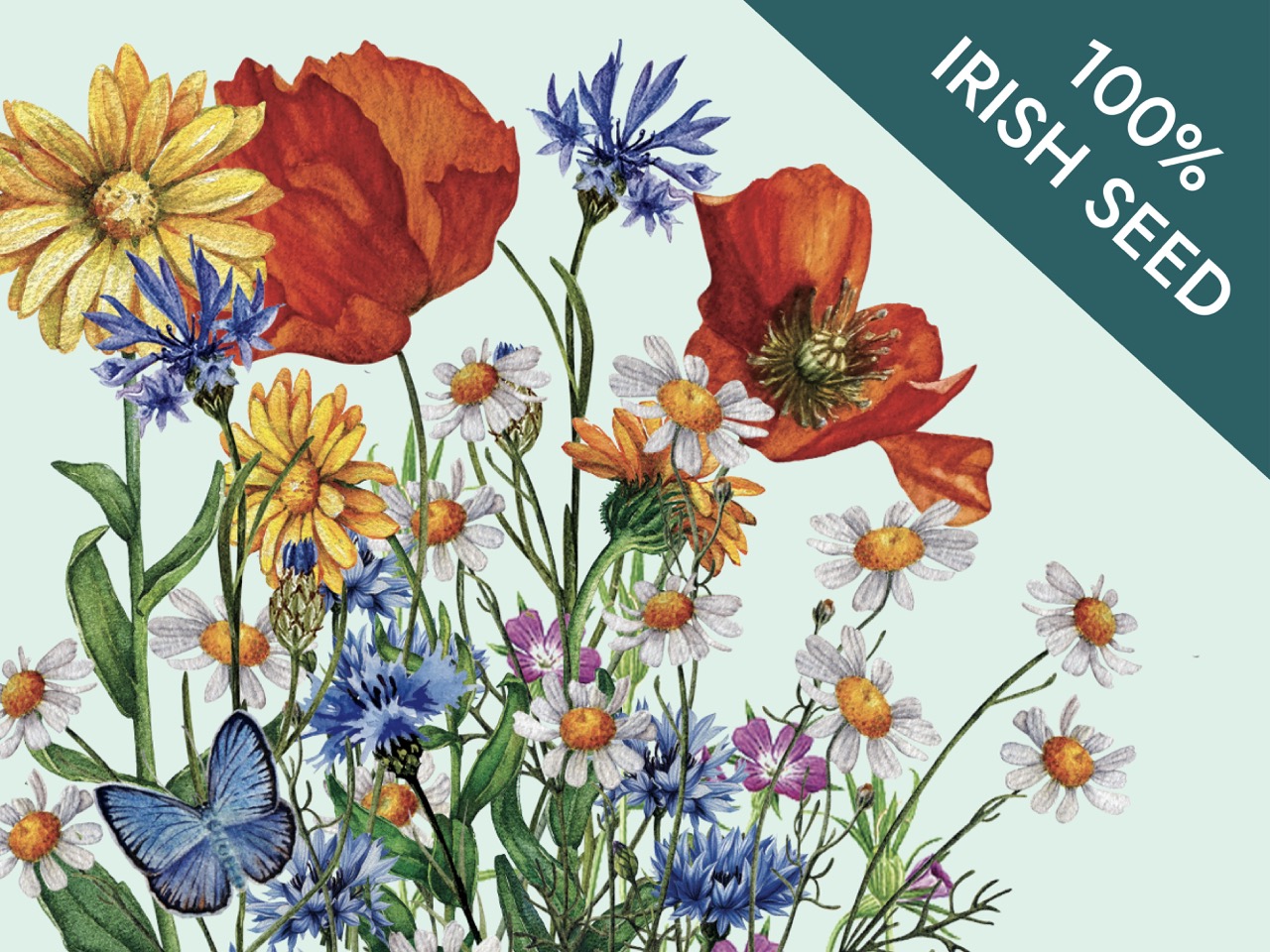Description
The Part Shade Hedgerow Wildflower mix produces colourful blooms in late spring. The mixture contains species found in semi-shaded areas throughout Ireland, which are nonetheless under threat from habitat loss.
Given time to establish itself (as well as careful maintenance), the diverse flora will persist as a thriving mini ecosystem, providing food and habitat for all kinds of wildlife.
This can be a tricky mixture to grow but is very rewarding. Make sure to follow the site preparation methods and maintenance advice (see the Instructions tab for more detailed info).
- Up to 80% of all seed should germinate in the first year.
- Up to 90% of all species should germinate in 24 months.
- Up to 95% of all species should have flowered by the fourth year after sowing.
- Late Autumn and early Summer sowings may be slow to emerge, depending on the weather.
Species List: Birdsfoot Trefoil, Black Meddick, Burdock, Bluebell, Corn Marigold, Corn Poppy, Corncockle, Cornflower, Cowslip, Devils Bit Scabious, Foxglove, Hedge Garlic Mustard, Hemp Agrimony, Broadleaf Plantain, Cow-Parsley, Lesser Knapweed, Scented Mayweed, Meadowsweet, Mullein, Ox-eye Daisy, Purple Loosestrife, Primrose, Ragged Robin, Red Campion, Ribwort Plantain, Sorrel, St Johnswort, Teasel, Upright Hedge Parsley, Wild Angelica, Wild Carrot, Wood Avens, Sweet Violet, Dog Violet.
Seed Mixture Specifications: Total number of seeds per gram: 2440
Suitable for soil type: All types of soil; Clay, Loam, Sand, Light Soil, Heavy Soil, and cultivated Peat
Moisture Level: Dry, Normal, Moist (but not flooded wet)
pH range: Best between 5. - 7.5
Aspect: Semi shade and shaded. The performance will be limited under very heavy tree canopies.
Life Cycle: Annual, Biennial & Perennial.
Height Range: <10cm to >180cm
Flowering Period: March to September.
Fertility Range: Will grow in very fertile soil to poor soil.
Wintergreen: Yes
- The main species which should dominate and persist in this mixture if the ground is kept free of grass and not cultivated: Cowslip, Devilsbit, Lesser Knapweed, Meadowsweet, Ox-eye Daisy, Purple Loosestrife, Ragged Robin, Ribwort Plantain, Sorrel, St Johnswort, Wood Avens
- Annual Species: Corn Marigold, Corn Poppy, Corncockle, Cornflower, Scented Mayweed.
- Biennial Species: Burdock, Foxglove, Mullein, Hedge Garlic Mustard, Teasel, Upright Hedge Parsley, Wild Angelica, Wild Carrot, Welsh Poppy.
- Rare, unusual, and feature species: White Foxglove (Found in Carlow; to keep pure, collect seed from white flowers and sow separately), Primrose
- Species which will grow if the conditions are ideal: Primrose, Sweet Violet, Dog Violet, Purple Loosestrife (prefers damp soil)
- Species which will be affected by management: Primrose - keep weed free until established. Primula species will germinate in the second or third year after sowing.
Will require occasional maintenance to rake the soil open for new seedlings to germinate. See the Instructions tab for more info on sowing and maintenance.
Product Warning: While this Ecotype mixture contains the seed of edible and herbal species, it's not for human or animal consumption as it contains species such as Corncockle, Hemp Agrimony, Bluebell and Foxglove which are toxic if ingested.
Instructions
Notes: Can be sown with grasses, but it's unnecessary.
This mixture will not require a nurse crop, as it contains annuals.
Tolerates moist or dry conditions, and can be sown in light or semi shade.
While the mixture will grow in full sun, it will perform best when there is some shade for part of the day.
The seed mixture will provide many species that are colourful in late spring.
In dry areas under trees it will produce about 8 final species.
In dry shady areas under trees and hedge's, Part Shade Hedgerow mix can be sown with Shady Woodland Wildflower Mix or woodland plants at the same time as you plant seed.
The woodland wildflowers will not flower in the first year. Some species are very slow to appear (you will have to wait 3 years for the primula).
This is a difficult mixture to grow. The area must be prepared and managed to the highest standards. Try to eliminate all nettles, Ivy and bramble by cutting or strimming the area, or by spraying.
Some species in this mixture are 'browse' resistant.
Sowing Specification: as normal; roll or rake into surface to keep out of reach from birds.
Soil Preparation: Normal; create fine tilt on seed bed.
Optimum Sowing Time: Autumn (after leaf fall if under trees) or September, or spring in semi-shade or full sun.
Sowing Conditions: Normal
Sowing Method: By hand is recommended; if using seed spreaders, be careful to ensure the small varieties of seed do not drop to the bottom of the seed spreader and get sown all in the one place. Can also be Hydrasown.
Fertiliser: None. Powdered or liquid seaweed will aid germination.
Seed Sowing Rates: 1.5 grams per metre.
Normal sowing rate 'without added grass seed': 1.5 grams per metre.
High sowing rate 'without added grass seed': Add 3 grams per metre.
Low sowing rate: None.
Grass seed or nurse crop requirement:
Nurse Crop: Annuals are part of mixture.
Grass Seed Requirement: None.
Sow with or without grasses: Unnecessary.
Maintenance
Persistence if unmanaged: Moderate.
Tolerance of Cutting: Moderate.
General Cutting Time: July or August, and early March to 10cm.
Specific Cutting Time: Wait 3 weeks until after the last flush of flowers fades away after seeds set in July.
Management: Strim. The third year is the critical year to maintain this meadow. Scutch grass, nettle and dock will try to dominate, as the growing conditions are ideal for such unwanted species.






